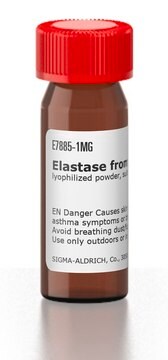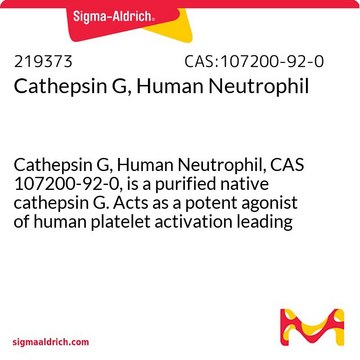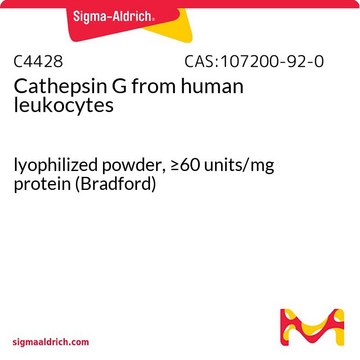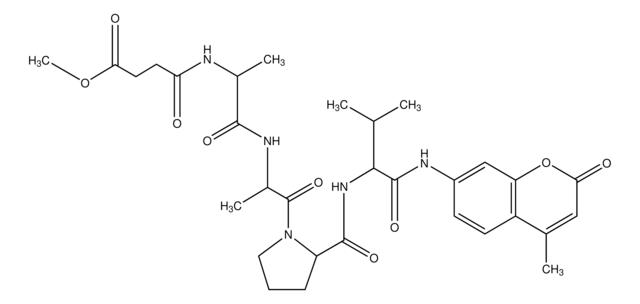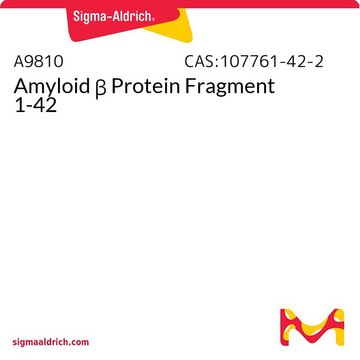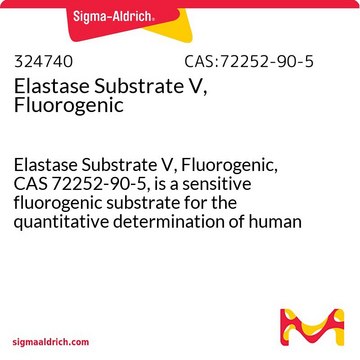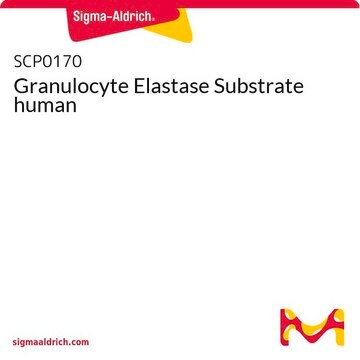Wszystkie zdjęcia(1)
Kluczowe dokumenty
E8140
Elastase from human leukocytes
lyophilized powder, ≥50 units/mg protein (Bradford)
Synonim(y):
Lysosomal elastase
Zaloguj sięWyświetlanie cen organizacyjnych i kontraktowych
About This Item
Numer CAS:
Numer MDL:
Kod UNSPSC:
12352204
NACRES:
NA.54
Polecane produkty
pochodzenie biologiczne
human leucocytes
Poziom jakości
Formularz
lyophilized powder
aktywność właściwa
≥50 units/mg protein (Bradford)
masa cząsteczkowa
29 kDa
numer dostępu UniProt
Warunki transportu
dry ice
temp. przechowywania
−20°C
informacje o genach
human ... ELA2(1991) , ELANE(1991)
Szukasz podobnych produktów? Odwiedź Przewodnik dotyczący porównywania produktów
Powiązane kategorie
Opis ogólny
Elastase is a proteolytic enzyme. It is a member of the subgroup named, peptidyl peptide hydrolases. It is a major anatomic constituent of arteries. It is mainly found in the pancreas and pancreatic juice of various birds and mammals. It is also present in human serum, granulocytes and erythrocytes.
Zastosowanie
Elastase from human leukocytes has been used:
- to measure serum elastase activity
- in proteolytic digestion of fibronectin and salivary glands
- in neutrophil elastase (NE) activity assay
- cell-free NE digestion of E-cadherin
- scratch wound assay
- in a study that determined that fragments of Nle3-angiotensin(1-7) accelerate healing in dermal models
Działania biochem./fizjol.
Elastase enzyme is capable of releasing soluble peptides from insoluble elastin fibers with the help of a proteolytic process. It can stimulate disintegration of the axoneme with the help of adenosine triphosphate (ATP). Unlike pancreatic elastase the leukocyte enzyme has a preferential cleavage for the carboxyl side of valine, but will also cleave to a lesser extent after alanine. Natural substrates include elastin, cartilage proteoglycans, collagen types I, II, II and IV, and fibronectin.
Właściwości fizyczne
Leukocyte elastase is a 29 kDa serine endoprotease of the Proteinase S1 Family. It exists as a single 238 amino acid-peptide chain with four disulfide bonds. It contains two or thee N-linked glycans of variable composition which account for its three major isoforms.
Isoelectric point: pI = 8.77 - 9.55
Isoelectric point: pI = 8.77 - 9.55
Definicja jednostki
One unit will release one nanomole of p-nitrophenol per sec from BOC-L-alanine p-nitrophenyl ester at pH 6.5 at 37 °C.
Postać fizyczna
Lyophilized from 0.05 M sodium acetate (pH 5.5) and 0.6 M NaCl
Ta strona może zawierać tekst przetłumaczony maszynowo.
Inhibitor
Zastosowanie
substrat
Numer produktu
Opis
Cennik
Kod klasy składowania
13 - Non Combustible Solids
Klasa zagrożenia wodnego (WGK)
WGK 1
Temperatura zapłonu (°F)
Not applicable
Temperatura zapłonu (°C)
Not applicable
Wybierz jedną z najnowszych wersji:
Masz już ten produkt?
Dokumenty związane z niedawno zakupionymi produktami zostały zamieszczone w Bibliotece dokumentów.
Klienci oglądali również te produkty
Koichiro Mihara et al.
The Journal of biological chemistry, 288(46), 32979-32990 (2013-09-21)
Neutrophil proteinases released at sites of inflammation can affect tissue function by either activating or disarming signal transduction mediated by proteinase-activated receptors (PARs). Because PAR1 is expressed at sites where abundant neutrophil infiltration occurs, we hypothesized that neutrophil-derived enzymes might
Carey A Hobbs et al.
American journal of physiology. Lung cellular and molecular physiology, 305(12), L990-L1001 (2013-10-15)
The epithelial sodium channel (ENaC) is responsible for Na(+) and fluid absorption across colon, kidney, and airway epithelia. Short palate lung and nasal epithelial clone 1 (SPLUNC1) is a secreted, innate defense protein and an autocrine inhibitor of ENaC that
III - Hydrolases
Enzymes of the Arterial Wall, 208-390 (1969)
Elastase: General Information1,2
Methods of Enzymatic Analysis, 2, 1041-1045 (1974)
Regulation of Dynein in Ciliary and Flagellar Movement
Dyneins, 366-393 (2012)
Chromatograms
application for HPLCNasz zespół naukowców ma doświadczenie we wszystkich obszarach badań, w tym w naukach przyrodniczych, materiałoznawstwie, syntezie chemicznej, chromatografii, analityce i wielu innych dziedzinach.
Skontaktuj się z zespołem ds. pomocy technicznej
